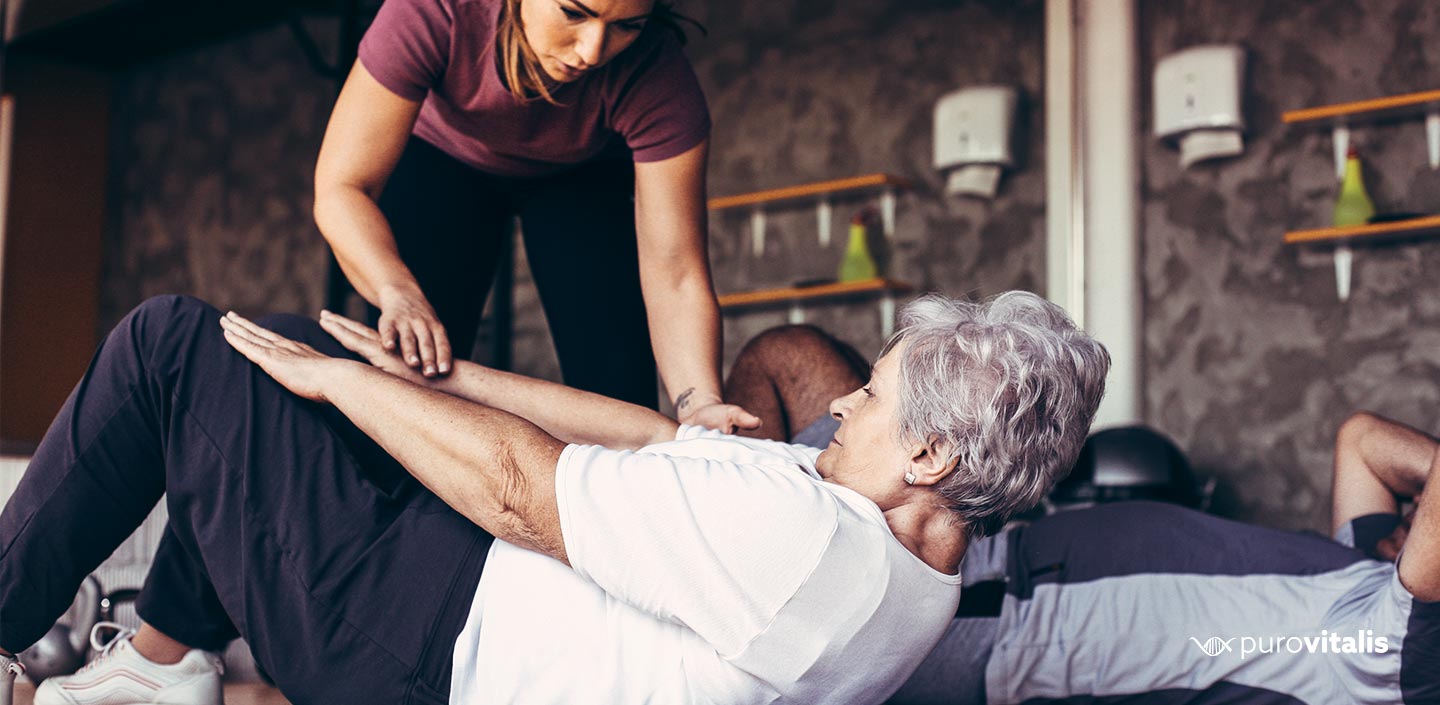
Senza dubbio, il potere dell'allenamento della forza o della resistenza e dell'inversione dell'invecchiamento è sottovalutato. L'invecchiamento è molto più dei capelli grigi o delle rughe sul viso che si sviluppano. Internamente, con l'invecchiamento del corpo, tutti gli organi vitali perdono un certo grado di funzionalità. L'invecchiamento produce cambiamenti in ogni singola cellula, in ogni singolo tessuto e in ogni singolo organo. A sua volta, ha un impatto negativo su tutti i sistemi del corpo e sulla loro capacità di funzionare in modo appropriato.
Come l'allenamento di resistenza ricostruisce forza e vitalità
Il segreto per invecchiare con grazia sta nello sfruttare una maggiore forza. La risposta sta nell'investire regolarmente nell'allenamento di resistenza. L'allenamento di resistenza è noto per aiutare a invertire l'invecchiamento! Il potenziale dell'allenamento di resistenza risiede nella capacità dell'uomo di ringiovanire e ricostruire fibre muscolari più importanti e più potenti, note come tipo II o muscolo a contrazione rapida. La cosa fantastica è che questo potenziale può essere liberato in un breve allenamento di circa 20 minuti, anche se eseguito in modo irregolare, ad esempio una o due volte alla settimana. Il vantaggio maggiore è che tiene conto della sicurezza, consentendo di personalizzare l'allenamento di resistenza - un approccio importante quando si considerano gli allenamenti per le persone anziane.
Nelle popolazioni anziane, l'allenamento di resistenza riduce i marcatori di stress ossidativo e aumenta l'attività degli enzimi antiossidanti. Melov e colleghi hanno verificato se l'allenamento di resistenza influisce su alcune espressioni geniche associate all'invecchiamento muscolare, invertendo così il processo di invecchiamento. Numerose ricerche e studi condotti da esperti forniscono prove solide e statisticamente significative del fatto che l'allenamento di resistenza negli adulti più anziani è utile per contrastare l'invecchiamento. Inoltre, tale allenamento di resistenza contribuisce a migliorare la forza muscolare e la funzione fisica.
Ecco 7 cose da sapere sul rapporto tra allenamento di resistenza e inversione dell'invecchiamento.
1. L'inversione dell'invecchiamento è un processo complesso
L'invecchiamento varia da persona a persona. Sebbene esistano molte teorie sui fattori che influenzano l'invecchiamento, alcune comuni includono il metabolismo corporeo, l'esposizione ai raggi UV dannosi, il codice genetico, i sottoprodotti alimentari e i farmaci. L'invecchiamento ha diversi effetti sul corpo. Di solito, l'invecchiamento negli esseri umani è associato a una perdita di muscoli e a un deficit di forza muscolare. A volte questo porta a una compromissione delle attività della vita quotidiana. In genere, questi cambiamenti iniziano a 40 anni e peggiorano progressivamente con l'invecchiamento, sia negli uomini che nelle donne. Tuttavia, indipendentemente dal motivo che sta alla base dell'invecchiamento, è confermato che gli esercizi, in particolare l'allenamento di resistenza, svolgono un ruolo enorme nell'inversione dell'invecchiamento.
2. L'allenamento di resistenza influenza la sarcopenia
La sarcopenia è nota come la perdita di massa, forza e funzione muscolare legata all'età. Anche se si tratta di un processo naturale, si stima che il 7% degli adulti di età superiore ai 70 anni e il 20% di quelli di età superiore agli 80 anni siano affetti da questa condizione molto dolorosa. Come descritto dalla ricerca di Simon Melov su questo argomento, pubblicata nel 2007, la sarcopenia costa al sistema sanitario degli Stati Uniti più di 18 miliardi di dollari all'anno! I fattori legati all'invecchiamento muscolare sono molteplici. Tra questi ci sono teorie e ricerche che suggeriscono che sia legato allo stress ossidativo, una condizione in cui i livelli di antiossidanti sono più bassi del normale. Altre ragioni includono la morte delle cellule, l'infiammazione del corpo, la disregolazione ormonale, l'inattività, le alterazioni del turnover proteico. Un'altra ragione, di tipo cellulare, è quella mitocondriale, in cui la fabbrica di energia ATP delle cellule è in disfunzione.

3. L'allenamento di resistenza aumenta la densità ossea
Questa condizione è chiamata anche DOMS o indolenzimento muscolare a insorgenza ritardata. A livello micro, ogni partecipante si aspetta un'inversione dell'invecchiamento dopo un buon allenamento. Sebbene l'allenamento di resistenza anti-invecchiamento provochi indolenzimento, rende le ossa più forti e più dense. Quando si pratica un allenamento di resistenza, le ossa vengono sollecitate dai movimenti e dagli schemi di forza. Questo porta le cellule che formano le ossa a mettersi al lavoro. Tuttavia, l'indolenzimento non deve essere confuso con il dolore del corpo. Forse è giunto il momento di abbandonare la cieca sequela del riferimento della cultura pop: "No pain, no gain". Di sicuro non è un approccio sostenibile all'anti-invecchiamento.
4. L'allenamento della resistenza consente di migliorare l'equilibrio e la funzionalità
Oltre a contribuire a un corpo più equilibrato, l'allenamento di resistenza migliora anche la funzionalità. I muscoli solidi contribuiscono a migliorare le funzioni quotidiane, prolungando l'invecchiamento. Le attività quotidiane, tra cui sedersi, camminare, recuperare qualcosa dall'alto e persino mettersi le scarpe, richiedono equilibrio, flessibilità e forza. Per gli anziani, queste attività comportano direttamente un aumento del rischio di cadute o di altri infortuni catastrofici, ma con una minore mortalità. L'allenamento anti-invecchiamento migliora anche la composizione corporea. Sebbene il corpo umano inizi a perdere massa muscolare dopo i 30 anni, il processo si accelera nel tempo se non si interviene. Sebbene l'invecchiamento e l'inattività siano i principali responsabili, la mancanza di una stimolazione più profonda e significativa delle fibre muscolari è responsabile di come ci sentiamo.
5. L'allenamento di resistenza migliora la massa muscolare
La correlazione più comune associata all'invecchiamento è la perdita di muscoli e forza. Ciò influisce sul metabolismo, sulle ossa e sull'acutezza mentale. Dopo i 30 anni si perdono circa due chili di massa muscolare per decennio. Una maggiore forza muscolare è stata collegata a una riduzione della mortalità negli uomini, a un metabolismo più veloce e a un miglioramento delle funzioni cognitive. Più muscoli significa più forza, migliore equilibrio e aumento del metabolismo. Uno studio ha rilevato che gli anziani hanno migliorato la loro massa e forza muscolare del 30%. Questi risultati scientifici indicano che l'allenamento di resistenza è progettato per combattere l'obesità e i disturbi ad essa correlati. Si tratta di diabete, malattie cardiache, ictus, ipertensione e cancro. Infatti, il mantenimento della massa muscolare è essenziale per ridurre le probabilità di obesità, soprattutto con l'avanzare dell'età.
6. L'allenamento della forza è più efficace del cardio per l'anti-invecchiamento
L'allenamento di resistenza e il reclutamento delle fibre muscolari di tipo II basate sulla forza sono più efficaci del cardio, della resistenza e dell'aerobica per la perdita di grasso e il controllo del peso. L'allenamento della forza converte le cellule del corpo in piccole macchine brucia-grassi. Uno studio innovativo ha scoperto che, contrariamente all'opinione comune, l'esercizio fisico impegnativo a lungo termine non è associato a un invecchiamento accelerato se l'esercizio è costituito esclusivamente da powerlifting con movimenti di resistenza completi come il deadlift e lo squat. Questa strategia può addirittura aumentare la lunghezza dei telomeri, il che significa che quanto più pesante è il carico che si esercita sui muscoli, tanto più lunghi saranno i telomeri.
7. L'allenamento della forza influisce sull'invecchiamento a livello genetico
L'allenamento della forza è collegato al rallentamento e all'inversione del processo di invecchiamento a livello cellulare e genetico. Questo porta a un aumento dell'energia, contribuendo all'inversione dell'invecchiamento, migliorando la resistenza all'insulina, riducendo la mortalità e migliorando la funzione cerebrale. Lo studio ha osservato che gli anziani che si allenavano con la forza almeno due volte alla settimana avevano una probabilità di morte inferiore del 46%. Avevano anche il 41% in meno di probabilità di morte cardiaca e il 19% in meno di probabilità di morire di cancro.
L'allenamento della forza rende il corpo umano efficiente: Un allenamento di 20 minuti può essere altrettanto valido di uno di 40 minuti! I movimenti composti, che comprendono più di un esercizio, danno il doppio dei benefici nella metà del tempo. Per questo motivo, è necessario condurre una ricerca adeguata per trovare una routine di allenamento per la forza che sia adatta alle proprie esigenze. Se praticato due o tre volte alla settimana, il corpo cambia in modo significativo nel tempo. Non solo, ma sarà utile anche per favorire l'inversione dell'invecchiamento. A lungo termine, migliorerà drasticamente la qualità della vita, come si vede nel caso degli anziani che partecipano regolarmente a un allenamento di resistenza e che spesso vedono migliorare il loro benessere psicosociale.

Tieni traccia di più di 50 metriche sulla salute con una precisione basata sull'intelligenza artificiale. Inizia la tua prova gratuita oggi stesso e prendi il controllo del tuo percorso di benessere!

Consigli per la longevità i migliori esercizi diete nutrizionali stile di vita sano
L'arte di vivere bene, una vita che non si misura solo con gli anni, ma con le esperienze, la salute e la gioia!












